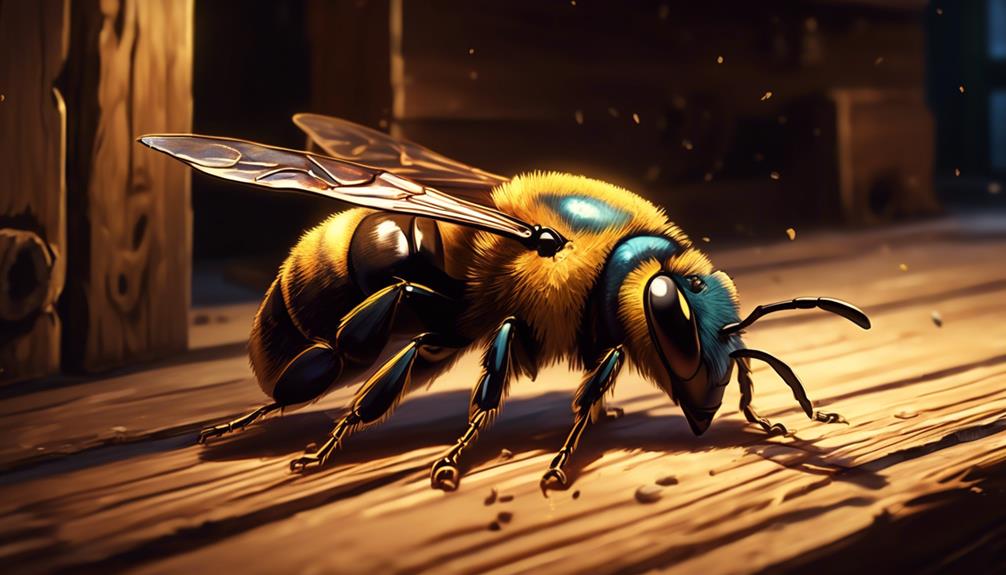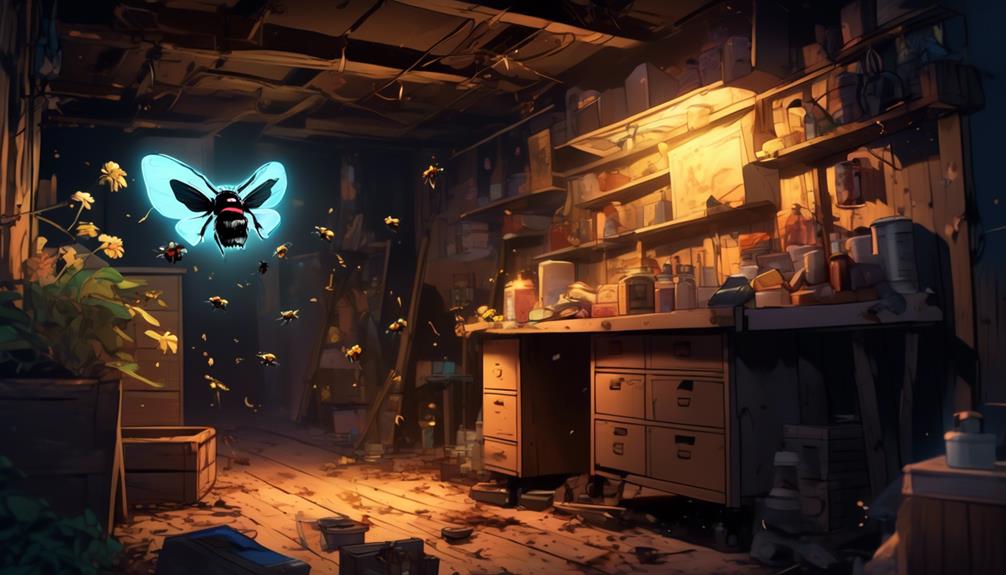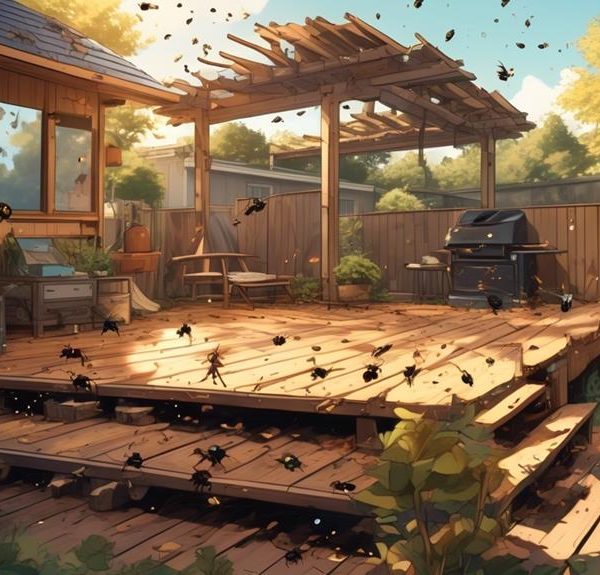Wondering if that carpenter bee in your basement is a threat to your home? Explore answers and solutions to your buzzing problem.

Carpenter Bee in My Basement
By some strange coincidence, you've stumbled upon a carpenter bee making itself at home in your basement. This isn't your typical bumblebee, no, this one's a woodworker with a reputation for turning solid timber into sawdust.
Now, you're facing a predicament that leaves you with more questions than answers. What brought it here? Is your beloved home at risk?
You're not alone in this; many have walked in your shoes, wrestling with similar uncertainties.
So, where do you go from here?
Key Takeaways
- Carpenter bees are large, solitary bees known for their wood-boring habits.
- Basements provide ideal nesting environments for carpenter bees due to their dark, quiet, and untreated wood.
- Identifying a carpenter bee infestation can be done by looking for large, bumblebee-like insects flying around the basement or exterior of the home, round holes in wood, and the presence of yellowish substance or wood shavings.
- Prompt action is necessary to remove carpenter bees and prevent structural and cosmetic damage to the home.
Understanding Carpenter Bees

To truly address the issue of a carpenter bee in your basement, it's essential to understand these intriguing insects, their biology, behavior, and peculiar penchant for burrowing into wood.
Carpenter bees, scientifically known as Xylocopa, are large, solitary bees primarily known for their wood-boring habits. Unlike termites that consume wood, these bees merely excavate tunnels for laying eggs and raising their offspring.
You'll find that a carpenter bee's biology is unique. They've robust bodies, metallic sheen, and most species exhibit sexual dimorphism, meaning males and females have distinct appearances. Behaviorally, they're solitary insects, and females are the builders, drilling nearly perfect circular holes into wood structures to form their nests.
The male's role is to guard the nest, and although they might seem aggressive, it's interesting to note that they lack a stinger. This is a common misconception that often leads to unnecessary panic.
Understanding these characteristics of carpenter bees can help you approach the problem of having them in your basement in a more informed and effective manner. After all, knowledge is power, especially when dealing with any wildlife in your personal space.
Why Bees Choose Basements

You might wonder why your basement, of all places, seems to attract these wood-boring visitors. It's because carpenter bees, unlike honey bees or bumblebees, aren't hive dwellers. Instead, they seek out wood, such as your basement's beams or furniture, to bore into and create nest tunnels.
Basements offer these bees several advantages. Firstly, they're dark and quiet, simulating the secluded environments that carpenter bees prefer for nesting. Secondly, basements often provide easy access to untreated wood, which is ideal for their nesting habits. Furthermore, these insects are attracted to damp environments, and many basements, due to their subterranean location, tend to be moist.
Understanding these factors doesn't mean you have to resign yourself to a basement buzzing with carpenter bees. In fact, it provides you with the knowledge you need to make your basement less inviting. Consider treating exposed wood with chemicals bees find repulsive, or sealing off potential entrances. Reducing dampness can also deter these wood-boring pests.
Identifying a Carpenter Bee Infestation

Armed with the knowledge of why carpenter bees might find your basement appealing, it's crucial to learn how to identify signs of an infestation. Your first clue may be the sight of large, bumblebee-like insects flying around your basement or the exterior of your home. Unlike bumblebees, carpenter bees are solitary creatures and have shiny, hairless abdomens.
Next, you'll want to inspect for physical signs of their presence. Carpenter bees bore nearly perfect, round holes about a half-inch in diameter into wood to build their nests. You may also notice a yellowish substance, which is a mix of pollen and bee excrement, around these holes.
Furthermore, be on the lookout for 'frass,' or wood shavings, near the entrance of the hole. The presence of frass is a telltale sign of active infestation as it indicates that the bee is currently excavating the tunnel.
Potential Risks and Damages

While carpenter bees don't pose a direct threat to human health, their wood-boring activities can cause considerable structural damage to your home over time. These bees excavate tunnels in wood to lay their eggs. Over several generations, these tunnels can become extensive, weakening the structural integrity of your woodwork.
Let's break down the potential damage these insects can cause:
Possible Damage | Description |
|---|---|
Structural Damage | Prolonged infestations can lead to serious damage, causing wooden structures to weaken or even collapse. |
Cosmetic Damage | The entrance holes bees make can be unsightly. Additionally, bees often leave stains below the holes due to expelled waste. |
Attract Other Pests | The tunnels made by carpenter bees can attract woodpeckers, who peck at the wood to reach the bee larvae inside. |
Damage to Furniture | If the bees infest wooden furniture, they can cause significant damage that may be difficult to repair. |
Given these potential risks and damages, it's crucial to address a carpenter bee infestation promptly. The sooner you act, the better chance you have to mitigate the damage and protect your home.
Effective Carpenter Bee Removal Techniques

Given the potential for significant structural and cosmetic damage, it's essential to tackle a carpenter bee infestation head-on with effective removal techniques. Your first step should be to accurately identify the nesting area. It might be a small hole, typically about half an inch in diameter, where sawdust or pollen may accumulate.
Next, you'll want to apply an insecticidal dust into the holes. This method ensures the pesticide reaches deep into the bee galleries, effectively eliminating the existing bees and preventing the re-infestation. You should apply the dust in the evening when the bees are less active.
After a few days, seal the holes with a wooden dowel coated in wood glue or caulk. This step prevents re-infestation by making the site less attractive for future nesting.
Conclusion
In conclusion, understanding carpenter bees plays a crucial role in identifying their presence in your basement. Remember, their choice of location is influenced by the availability of unpainted, weathered wood. A carpenter bee infestation could cause significant structural damage to your home.
Therefore, it's essential to apply effective removal techniques promptly. Always stay vigilant to safeguard your home from these industrious, wood-boring insects.


